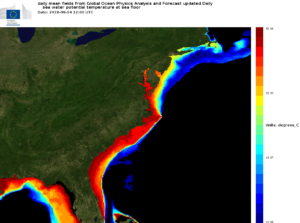-
Isothermal shelf waters and Florence
Posted on September 14th, 2018 No commentsFlorence is approaching Wilmington NC as a category 1 storm according to the National Hurricane Center https://www.nhc.noaa.gov/text/refresh/MIATCDAT1+shtml/140842.shtml
It’s slowed down significantly and is still sitting over warm coastal ocean waters. Glider data profiles from RAMSES to the north of Florence and PELAGIA to the south of Florence in previous posts have shown that the continental shelf of the South Atlantic Bight is isothermal, or uniformly warm from top to bottom. Additionally, with the approach angle of Florence winds look to be downwelling favorable meaning that any cold bottom water on the outer shelf was or is likely being advected offshore, while warm surface water is potentially being advected onshore.
This means that despite vigorous mixing in the coastal ocean there is not likely to be any ocean cooling on the shelf, as there simply isn’t any cold water available to mix to the surface. Bottom temperatures from the European Mercator model show warm bottom temperatures across the entire SAB in contrast to the cold bottom temperatures in the MAB.

Florence has been a slow moving storm over the continental shelf and with little ocean cooling these warm waters will likely not help weaken the storm.
A new batch of glider profiles are coming in this morning to confirm this, but overall this highlights the large differences in regional coastal ocean water masses and highlights processes that we’ll want to investigate in the coming years to better understand how coastal oceans affect storm intensity ahead of landfall.
Last 5 posts by Travis Miles
- Sally Approaching SG601 - September 13th, 2020
- Coupled Modeling of Fay - July 12th, 2020
- Michael Gulf of Mexico SST anomaly and ocean response - October 11th, 2018
- Hurricane Michael glider model comparisons for October 9th - October 10th, 2018
- Navy Glider Model Comparisons for Hurricane Michael - October 8th, 2018



